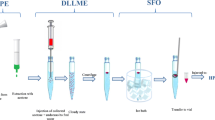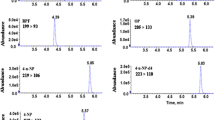Abstract
Combination of the quick, easy, cheap, effective, rugged, and safe (QuEChERS) method with ionic liquid-dispersive liquid–liquid microextraction (QuEChERS-IL-DLLME) was developed as an extraction methodology to determine bisphenol A (BPA) in various canned food samples prior to high-performance liquid chromatography ultraviolet detection (HPLC-UV). The potential variables affecting the microextraction recovery were considered in the optimization process. Obtained results showed that 1-hexyl-3-methylimidazolium bis(trifluoromethylsulfonyl)imide ([C6mim][Tf2N]) is a better extraction solvent compared with 1-hexyl-3-methylimidazolium hexafluorophosphate ([C6mim][PF6]) and is more compatible with RP-HPLC. Under the optimum conditions, the method yielded a linear calibration curve ranging from 1.0 to 500 μL−1 with a determination coefficient (R 2) of 0.9993. Enrichment factor for BPA was 98, and limit of detection was 0.1 μg L−1. The relative standard deviation percent (RSD%) for the intra-day and inter-day extraction and determination at 2.0, 20, and 200 μg L−1 levels of BPA was less than 7.2 % (n = 6) and 9.7 % (n = 6), respectively. Finally, the proposed method was successfully applied for the extraction, cleanup, preconcentration, and determination of the BPA in different canned food samples, and satisfactory results were obtained (relative recovery ≥90 %).





Similar content being viewed by others
Reference
Anastassiades M, Lehotay SJ, Stajnbaher D, Schenck FJ (2003) Fast and easy multiresidue method employing acetonitrile extraction/partitioning and “dispersive solid-phase extraction” for the determination of pesticide residues in produce. J AOAC Int 86:412–431
Asensio-Ramos M, Ravelo-Pérez LM, González-Curbelo MA, Hernández-Borges J (2011) Liquid phase microextraction. Applications in food analysis. J Chromatogr A 1218:7415–7437
Biparva P, Ehsani M, Hadjmohammadi MR (2012) Dispersive liquid–liquid microextraction using extraction solvents lighter than water combined with high performance liquid chromatography for determination of synthetic antioxidants in fruit juice samples. J Food Compos Anal 27:87–94
Braunrath R, Cichna M (2005) Sample preparation including sol-gel immunoaffinity chromatography for determination of bisphenol A in canned beverages, fruits and vegetables. J Chromatogr A 1062:189–198
Canale F, Cordero C, Baggiani C, Baravalle P, Giovannoli C, Bicchi C (2010) Development of a molecularly imprinted polymer for selective extraction of bisphenol A in water samples. J Sep Sci 33:1644–1651
Commission Regulation EU 10/2011 of 14 January 2011 on plastic materials and articles intended to come into contact with food. Chapter 13, 045:42–130
Cunha SC, Fernandes JO (2013) Assessment of bisphenol A and bisphenol B in canned vegetables and fruits by gas chromatography–mass spectrometry after QuEChERS and dispersive liquid–liquid microextraction. Food Control 33:549–555
Cunha SC, Almeida C, Mendes E, Fernandes JO (2011) Simultaneous determination of bisphenol A and bisphenol B in beverages and powdered infant formula by dispersive liquid-liquid micro-extraction and heart-cutting multidimensional gas chromatography-mass spectrometry. Food Add Contam Part A 28:513–528
European Food Safety Authority—EFSA (2006) Opinion of the scientific panel on food additives, flavourings, processing aids and materials in contact with food (AFC) related to 2,2-bis(4-hydroxyphenyl)propane. EFSA J 428:1–6
Farajzadeh MA, Khorram P, Alizadeh Nabil AA (2014) Solid-based disperser liquid-liquid microextraction for the preconcentration of phthalate esters and di-(2-ethylhexyl) adipate followed by gas chromatography with flame ionization detection or mass spectrometry. J Sep Sci 37:1177–1184
Farajzadeh MA, Abbaspour M, Afshar Mogaddam MR, Ghorbanpour H (2015) Determination of some synthetic phenolic antioxidants and bisphenol A in honey using dispersive liquid–liquid microextraction followed by gas chromatography-flame ionization detection. Food Anal Methods 8:2035–2043
Garcia-Prieto A, Lunar L, Rubio S, Pérez-Bendito D (2008) Decanoic acid reverse micelle-based coacervates for the microextraction of bisphenol A from canned vegetables and fruits. Anal Chim Acta 617:51–58
Gyong Y, Shin JH, Kim H-Y, Khim J, Lee M-K, Hong J (2007) Application of solid-phase extraction coupled with freezing-lipid filtration clean-up for the determination of endocrine-disrupting phenols in fish. Anal Chim Acta 603:67–75
Jafarvand S, Shemirani F (2011) Supramolecular-based dispersive liquid-liquid microextraction: a novel sample preparation technique utilizes coacervates and reverse micelles. J Sep Sci 34:455–461
Kang J-H, Kondo F, Katayama Y (2006) Importance of control of enzymatic degradation for determination of bisphenol A from fruits and vegetables. Anal Chim Acta 555:114–117
Li X, Guo R, Zhang X, Li X (2012) Extraction of glabridin using imidazolium-based ionic liquids. Sep Purif Technol 88:146–150
Munguia-Lopez EM, Peralta E, Gonzalez-Leon A, Vargas-Requena C, Soto-Valdez H (2002) Migration of bisphenol A (BPA) from epoxy can coatings to jalapeño peppers and an acid food simulant. J Agric Food Chem 50:7299–7302
Nerin C, Philo MR, Salafranca J, Castle L (2002) Determination of bisphenol-type contaminants from food packaging materials in aqueous foods by solid-phase microextraction–high-performance liquid chromatography. J Chromatogr A 963:375–382
Pandey S (2006) Analytical applications of room-temperature ionic liquids: a review of recent efforts. Anal Chim Acta 556:38–45
Passos H, Sousa ACA, Pastorinho MR, Nogueira AJA, Rebelo LPN, Coutinho JAP, Freire MG (2012) Ionic-liquid-based aqueous biphasic systems for improved detection of bisphenol A in human fluids. Anal Methods 4:2664–2667
Poole CF, Lenca N (2015) Green sample-preparation methods using room-temperature ionic liquids for the chromatographic analysis of organic compounds. Trac-Trend Anal Chem 71:144–156
Rai S, Singh AK, Srivastava A, Yadav S, Siddiqui MH, Reddy Mudiam MK (2016) Comparative evaluation of QuEChERS method coupled to DLLME extraction for the analysis of multiresidue pesticides in vegetables and fruits by gas chromatography-mass spectrometry. Food Anal Methods 9(9):2656–2669
Rezaee M, Assadi Y, Milani Hosseini MR, Aghaee E, Ahmadi F, Berijani S (2006) Determination of organic compounds in water using dispersive liquid–liquid microextraction. J Chromatogr A 1116:1–9
Rezaee M, Yamini Y, Shariati S, Esrafili A, Shamsipur M (2009) Dispersive liquid–liquid microextraction combined with high-performance liquid chromatography-UV detection as a very simple, rapid and sensitive method for the determination of bisphenol A in water samples. J Chromatogr A 1216:1511–1514
Rezaee M, Yamini Y, Faraji M (2010) Evolution of dispersive liquid–liquid microextraction method. J Chromatogr A 1217:2342–2357
Sadeghi M, Nematifar Z, Fattahi N, Pirsaheb M, Shamsipur M (2016) Determination of bisphenol A in food and environmental samples using combined solid-phase extraction-dispersive liquid–liquid microextraction with solidification of floating organic drop followed by HPLC. Food Anal Methods 9(6):1814–1824
Safe SH (2000) Endocrine disruptors and human health—is there a problem? An update Environ Health Perspect 108:487–493
Saleh A, Yamini Y, Faraji M, Rezaee M, Ghambarian M (2009) Ultrasound-assisted emulsification microextraction method based on applying low density organic solvents followed by gas chromatography analysis for the determination of polycyclic aromatic hydrocarbons in water samples. J Chromatogr A 1216:6673–6679
Shao B, Han H, Tu X, Huang L (2007) Analysis of alkylphenol and bisphenol A in eggs and milk by matrix solid phase dispersion extraction and liquid chromatography with tandem mass spectrometry. J Chromatogr A 850:412–416
Sun C, Leong LP, Barlow PJ, Chan SH, Bloodworth BC (2006) Single laboratory validation of a method for the determination of bisphenol A, bisphenol A diglycidyl ether and its derivatives in canned foods by reversed-phase liquid chromatography. J Chromatogr A 1129:145–148
Suzuki N, Hattori A (2003) Bisphenol a suppresses osteoclastic and osteoblastic activities in the cultured scales of goldfish. Life Sci 73:2237–2247
Tai Z, Li Y, Liu M, Hu X, Yang Y, Qin B (2014) Determination of bisphenol A and bisphenol AF in vinegar samples by two-component mixed ionic liquid dispersive liquid-phase microextraction coupled with high performance liquid chromatography. J Chem Soc Pak 36:63–67
Toyo’oka T, Oshige Y (2000) Determination of alkylphenols in mineral water contained in PET bottles by liquid chromatography with coulometric detection. Anal Sci 16:1071–1076
Trujillo-Rodríguez MJ, Rocío-Bautista P, Pino V, Afonso AM (2013) Ionic liquids in dispersive liquid-liquid microextraction. Trac-Trend Anal Chem 51:87–106
U.S. Food and Drug Administration-USFDA (2010) Bisphenol A (BPA): use in food contact application. 2014 Updated Review of Literature and Data on Bisphenol A, pp 120–129
Wang S, Liu C, Yang S, Liu F et al (2013) Ionic liquid-based dispersive liquid–liquid microextraction following high-performance liquid chromatography for the determination of fungicides in fruit juices. Food Anal Methods 6:481. doi:10.1007/s12161-012-9402-x
Wang L, Zhang D, Xu X, Zhang L (2015) Application of ionic liquid-based dispersive liquid phase microextraction for highly sensitive simultaneous determination of three endocrine disrupting compounds in food packaging. Food Chem 197:754–760
Wu T, Wang WY, Jiang LM, Chu QC, Delaire J, Ye JN (2008) Determination of natural and synthetic endocrine-disrupting chemicals (EDCs) in sewage based on SPE and MEKC with amperometric detection. Chromatographia 68:339–344
Zhan W, Wei F, Xu G, Cai Z, Du S, Zhou X, Li F, Hu Q (2012) Highly selective stir bar coated with dummy molecularly imprinted polymers for trace analysis of bisphenol A in milk. J Sep Sci 35:1036–1043
Acknowledgments
This study was funded by Standard Research Institute of Iran (grant number 45565).
Author information
Authors and Affiliations
Corresponding author
Ethics declarations
Conflict of Interest
Mohammad Faraji declares that he has no conflict of interest. Mahsa Noorani declares that she has no conflict of interest. Banafshe Nasiri Sahneh declares that she has no conflict of interest.
Ethical Approval
This article does not contain any studies on human or animal subjects.
Informed Consent
Not applicable.
Rights and permissions
About this article
Cite this article
Faraji, M., Noorani, M. & Nasiri Sahneh, B. Quick, Easy, Cheap, Effective, Rugged, and Safe Method Followed by Ionic Liquid-Dispersive Liquid–Liquid Microextraction for the Determination of Trace Amount of Bisphenol A in Canned Foods. Food Anal. Methods 10, 764–772 (2017). https://doi.org/10.1007/s12161-016-0635-y
Received:
Accepted:
Published:
Issue Date:
DOI: https://doi.org/10.1007/s12161-016-0635-y




